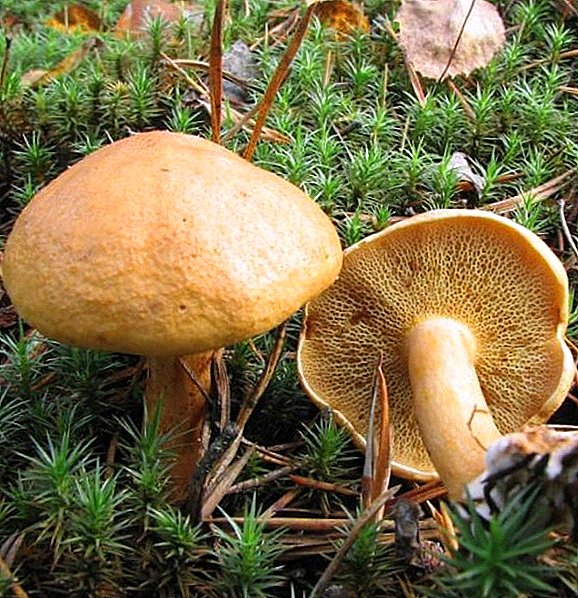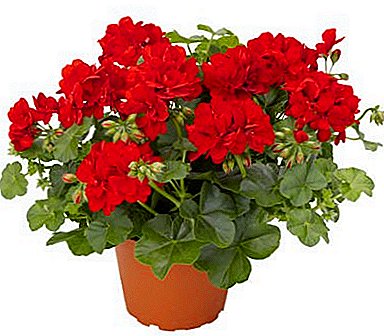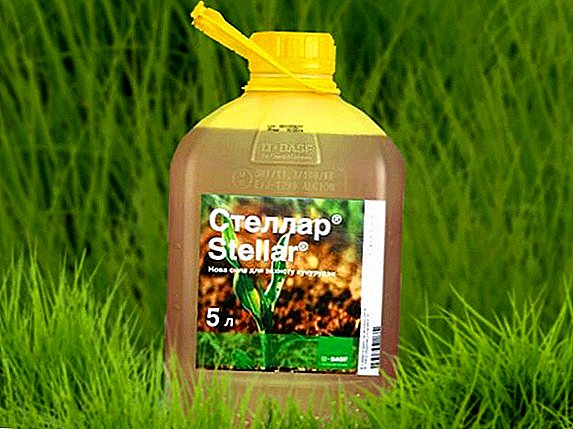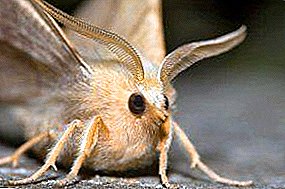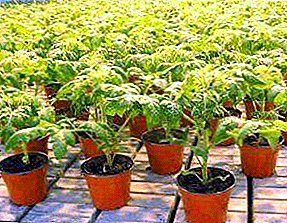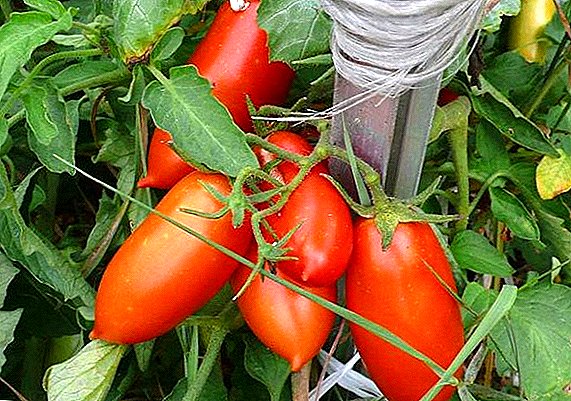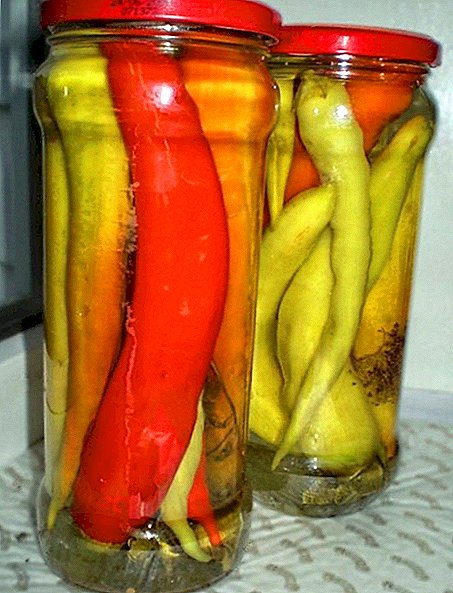 Gasteria is ideal for those florists who choose unpretentious succulent plants for home cultivation. Even in the absence of pronounced flowering, they always attract the eye with their simplicity and sophistication, especially if you take into account the characteristics of each individual species. What you should know about Gaster and how to properly organize care for her at home - this will be discussed in this article.
Gasteria is ideal for those florists who choose unpretentious succulent plants for home cultivation. Even in the absence of pronounced flowering, they always attract the eye with their simplicity and sophistication, especially if you take into account the characteristics of each individual species. What you should know about Gaster and how to properly organize care for her at home - this will be discussed in this article.
Botanical description of indoor plants
High decorativeness of Gaster is largely due to the presence of fleshy leaves, pointed or rounded, with a characteristic bright pattern or without it. Almost all of them are held by the short stem part and are arranged in several rows, except that the specific color will depend on the type chosen: the main background varies from dark to light green tones, and on top of it there are clearly visible point-like or strip-like stains of the light color, which create unusual fancy patterns. The maximum length of the leaves is 30 cm, but in some species they do not grow more than 10 cm.
Did you know? In the people, Gaster is sometimes called the “pot-bellied vessel”, which is explained by the presence of a peculiar bulge in the lower part of the perianth.
An increase in the overall decorativeness of Gaster is observed during the period of active flowering, when among the dense and fleshy leaves appear long peduncles, growing to 40-70 cm (formed after each circle of leaf plates). Separate small flowers are collected in brush-like inflorescences and are characterized by color transitions in their color: on average, between yellow, green and orange shades.
The most popular types of Gaster today are the following:
- Warty - the stem is completely absent, the leaves-tongues grow up to 20 cm and covered with small white warts.
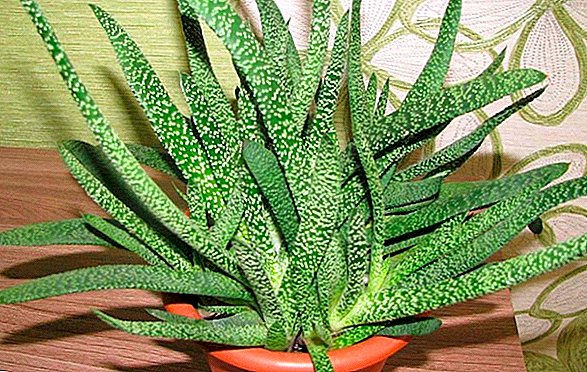
- Kilevataya - characterized by a spiral arrangement of dirty green leaves with white dots that grow up to 12-15 cm in length.
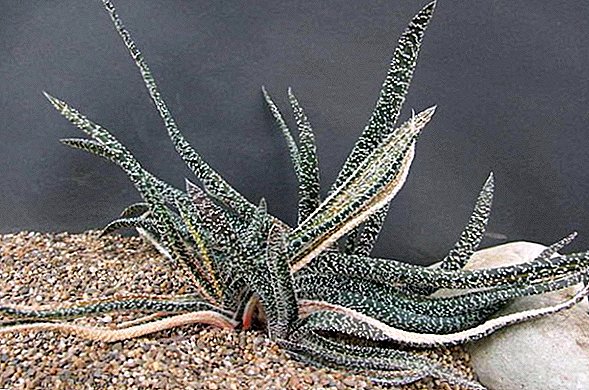
- Spotty - distinguished by the presence of a 30-centimeter trunk and long, light green foliage with white spots.
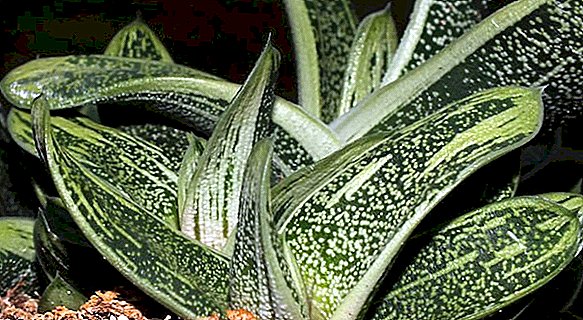
- Tiny - The length of the leaves does not exceed 6 cm, but like in other species they are completely covered with bright spots.
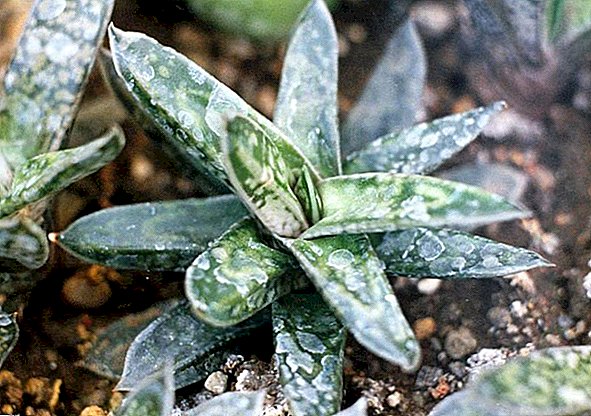
- Little varti - reaches a height of 20 cm and, like many other varieties, has a characteristic pattern on the surface of the leaves.
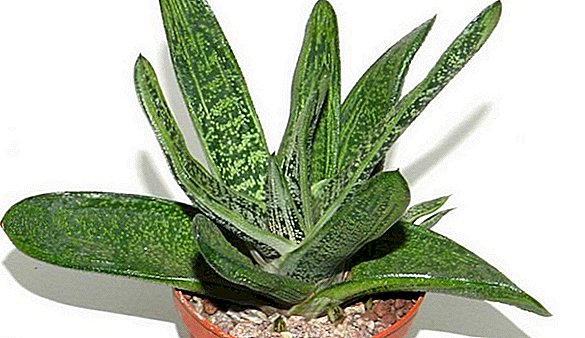
- Armstrong - The length of the rounded and shriveled leaf plates does not exceed 3 cm, and instead of light spots on it are clearly visible convex points.
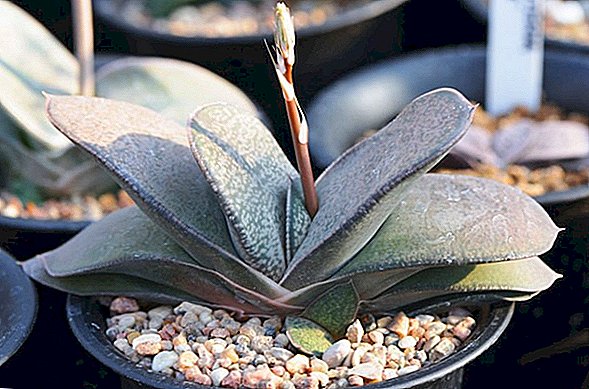
- Two-tone - leaves - up to 30 cm, ribbed and spotty.
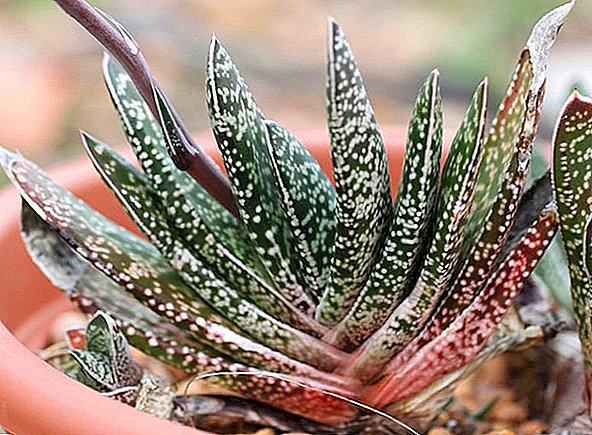
- Saber-shaped - on a light green background of 30-centimeter narrow leaves, bright shapeless spots are clearly visible, in some places they melt into one spot.
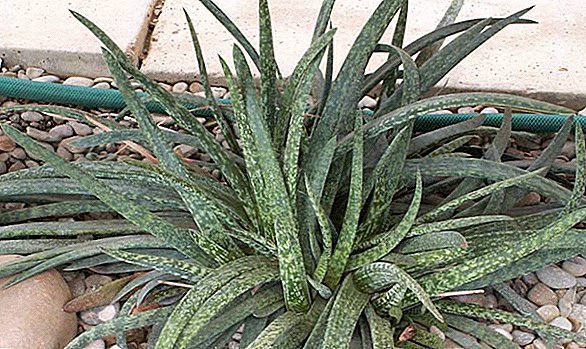
- Shaggy - leaf plates up to 14 cm in length, slightly convex at the top.
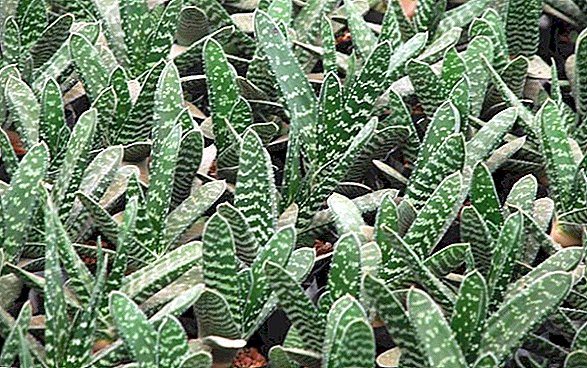
Conditions for growing at home
Given the relatively high simplicity of Gaster in terms of care, there is nothing unusual in the activities performed. For a good state of health of the plant, all you have to do is to properly place the pot, and then organize appropriate watering, fertilizing and pruning (if necessary).
Location and lighting
In the natural habitat of Gasteria, larger bushes always cover up, so it is protected from direct sunlight. When growing a house, she needs to create as similar conditions as possible, pritenaya during the summer heat. The ideal place in this case would be the site at the south-east or south-west window, with blinds or mesh curtains. In addition, it is good if it is protected from drafts and a sudden gust of wind, which may well harm the succulent.
The best neighbors for the described plant are cacti, among which Gaster perfectly grows and develops.
Did you know? In addition to visual appeal, leaves of Gasteri are characterized by an excellent ability to produce oxygen in the dark, and for this reason it is recommended to be placed in living rooms or bedrooms.
Air temperature and humidity
In summertime, the optimum temperature values for succulents will be within + 18 ... + 25 ° С, but in the winter dormancy, it is desirable to lower them to + 6 ... + 12 ° С. In the future, this will contribute to a spectacular and lush flowering, but if the temperature in the room is not lowered, then it is likely that there will be no flowering: an elevated temperature in winter leads to shrinkage and subsidence of the inflorescences.
Humidity is not so important for an exotic plant, therefore, when growing in apartment conditions, no additional measures are required to change the current values.

Home care
Having chosen the place of cultivation for exotic, it’s time to give proper attention to the issue of caring for it, taking into account the need for moisture and nutritional compositions.
Watering rules
The soil in a pot with a hysteria can dry out a little, which is considered quite normal for this type of plant. More deadly for them stagnant moisture, which often leads to the development of putrefactive processes. In summertime, the regularity of soil moistening may not exceed 2-3 times a month, and in winter, irrigation reduces even more: up to about 1 time per month. Irrigation liquid should always be at room temperature, pre-filtered and settled, and bring it into the soil preferably with a basal method, especially during the flowering period of the plant, which will help avoid wetting of flower petals.
Important! It is strictly forbidden to spray succulent from a spray bottle or, especially, to “bathe” it under a shower, otherwise the possibility of the development of fungal diseases localized between the leaves cannot be ruled out.
Top dressing
Initially, it is possible to use a ready substrate for cacti for planting Gasteria, which can be easily purchased at any flower shop. When independently preparing a nutrient mixture, it is possible to include turf and leafy soil, as well as a mixture of peat and sand in its composition, observing the proportions 5: 3: 2: 4. However, such a soil does not guarantee the well-being of a succulent for a long time, therefore seasonal supplements (May-October) will not be superfluous.
As a nutrient mixture, you can use complex mineral fertilizer for cacti, reducing the dosage recommended by the manufacturer by half. The regularity of nutrient mixes in the soil - once every 2-3 weeks. In the cold season (from November to April), it is better not to feed Gastrium, providing complete rest to the plant.

Pruning
Trimming of the Gaster is done only for sanitary purposes, when it is necessary to remove dried leaves and flower stalks. The plant does not need the forming procedure, as it is able to regulate the length of the leaves by itself and always looks as attractive as possible, in accordance with its appearance. When transplanting, you can prune rotten roots, be sure to dust the cut areas with pounded charcoal.
Transfer
Gasteria negatively reacts to any violations of its usual state; therefore, transplantation is recommended only as a last resort, when the previous planting capacity has become cramped, or because of waterlogging, the root system may rot, with the further death of the succulent.
Perform the procedure once a year, mostly in the spring time, immediately after the end of the rest period. A new pot should be 2-3 cm wider than the previous one, but not too deep for the root system to be too spacious. 
The transplanting process requires a certain accuracy from the grower and is carried out in accordance with the following plan:
- At the bottom of the new planting capacity 2-cm layer lay broken bricks or clay, which will serve as a drainage.
- Approximately half of the pot, pour the ready soil mixture for cacti or personally prepared substrate, using leaf, sod land, peat and sand.
- Carefully move the extracted plant from the old pot to a new one, trying to keep the earthen room.
- Top up the soil and water the plant.
Important! After transplantation, Gaster does not need to be disturbed during the first 3-4 days, it must fully recover after the transplantation and only then it will begin to be watered and fed again.
Flowering period
The flowering of most species of Gaster can be observed starting from the end of spring or at the beginning of the first summer month. On average, flowers remain on it for at least one month, but it is unlikely that it will take longer than two months to enjoy the beauty of a succulent. The shape of the emerging flowers resembles swollen bottles, which are always placed on long peduncles, up to 45-70 cm in length.
During the flowering period it is very important not to influence the succulent in any way: by no means changing the temperature in the room or moving the pot. In the most comfortable conditions of growth very soon Gasteria will throw out seed pods, which can be used for plant reproduction.
Breeding
It is possible to propagate an exotic home plant in several ways, but most often this happens either with the help of ready-made seeds, or with the use of daughter rosettes, which sooner or later form on any specimen. Consider the features of the procedure in each of these cases. 
Child Outlets
The vegetative breeding method is deservedly considered the easiest to obtain new plants, while preserving all the main characteristics of the mother bush.
In the case of Gasteria, the sequence for completing the task will be as follows:
- Prepare as many new pots as you need for planting all the available babies. As with the transplant of adult plants, be sure to put a drainage layer on the bottom and pour the prepared soil mixture on top (up to about 1/3 of the total volume).
- Carefully remove the donor plant from the old pot and at the point of attachment to the central part of the daughter outlets, separate each of them, making sure in advance of a well-developed own root system. It is better not to take specimens with lethargic or very small roots, it is likely that they still need a little time to develop in the same place.
- Place each withdrawn outlet into the appropriate pot and cover it with soil to the top, leaving at least 1 cm of free space to the edge of the pot.
The remaining mother bush can be returned to the old pot or immediately replace it with a new planting container.
Video: Reproduction of Gasteria by division
Seeds
Propagation of the plant with seeds provides for the preliminary collection of ripened peduncles and their drying before sowing in moistened sand. The placement of seeds in the planting tanks is performed by the surface method: they are simply laid out on the surface of fluffy sand (the distance between adjacent seeds must be at least 2 cm) and gently sprinkle them on top. At the end of the process, it remains only to cover the plantations with glass and take them to a warm room, with a temperature not lower than + 25 ° C.
Further care of the seedlings is based on the regular wetting of the substrate and the daily airing of plantings. The first young shoots will appear after 1.5-2 months after planting, and in a few more weeks they can be picked at separate small containers or directly into pots with permanent nutrient soil.
Important! Another method of vegetative propagation of Gaster is cutting, using cut leaf (before planting in prepared soil, it should dry well, at least within 2-3 days). However, to quickly get a full-fledged new plant in this way is unlikely to succeed, therefore, most experienced flower growers recommend reproduction by affiliated rosettes - children.
Diseases and pests
Diseases of Gaster are not as terrible as pests, but in case of violation of the irrigation regime or dressings, it is possible decay of the rhizome and base of the leaves (gray mold). To eliminate this problem, it is necessary to normalize the soil moisture level and remove the tainted parts of the flower.
From pests, increased activity differ mealybug, scales and aphid. In the first case, waxy traces of white will be clearly visible on the plant, in the second, white spots may appear on the leaves, but the presence of aphid colonies will be noticeable externally, just look at the inside of the leaf plates.
In the fight against each pest will always help special insecticidal compositions, the most popular of which are the drugs "Aktellik", "Phosbecid", "Aktara". If plants are partially damaged, folk remedies can help: for example, soap and alcohol solutions used to wipe leaves. While the pests are few, one-time processing will be enough, but if the case is running, then you will have to repeat the procedure in 10-14 days. 
Unfortunately, having successfully overcome difficulties once, one cannot be sure that there will be no problems in the future, therefore, when growing up Gasteria, constantly monitor its condition and do not allow even the slightest violations in care. Only in this way your plant will always be healthy and will be able to please others with its appearance.











